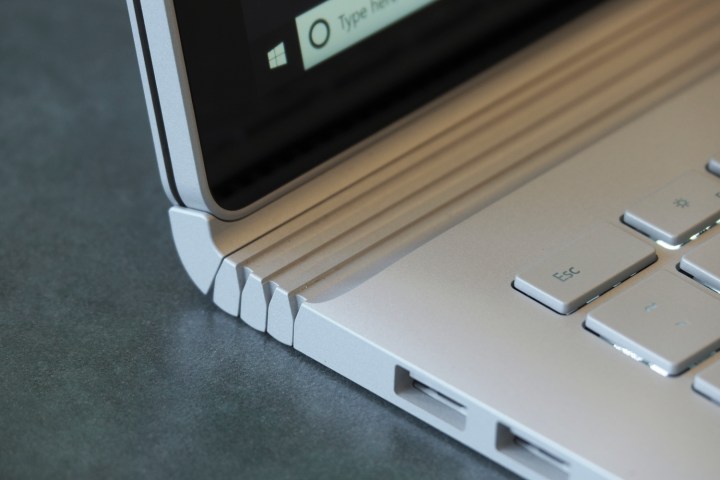
Apple could potentially eliminate the plastic strip found on today’s MacBook and MacBook Pro laptops in a future redesign if it brings its patent for a living hinge to life. The MacBook maker is continuing its research into a living hinge, which would allow the MacBook’s hinge to be constructed from a single material — Apple currently employs aluminum in its current laptop lineup — to create a stronger, more durable hinge on laptops.
Apple started work on its living hinge in 2013, and the patent filing was recently updated to state that the design would be used on a laptop, according to Patently Apple. “An enclosure for a laptop may be created from a rigid material having a flexible portion defined around approximately a midpoint of the material,” Apple wrote. “The flexible portion may allow the rigid material to be folded in half and thus acts as a laptop clamshell. In this manner, the enclosure (or a portion thereof) may be created from a single rigid material, while still providing flexibility and bending for the enclosure.”
Rival Microsoft already uses a similar type of hinge design on its Surface Book laptops. Microsoft’s dynamic fulcrum hinge is constructed using the same magnesium alloy as the rest of the laptop to form a durable design, but the downside is that unlike traditional notebook hinges there is a slight gap between the screen and the keyboard portion near the hinge when the laptop is closed. Because the screen on the Surface Book can be detached, Microsoft’s use of the dynamic fulcrum hinge to strengthen the mechanism at the laptop’s more highly stressed point, to mitigate breaking, makes sense.

In its design patent filed with the European Patent Office, Apple said that the hinge would be made with “interlocking flexible segments formed from a rigid material,” and design illustrations show that metal, carbon fiber, composites, ceramics, glass, plastic, and other materials could be used to construct the shell of the laptop and the rigid hinge. While Apple notes that the clamshell design could be used for a MacBook, it said that such a design could also apply to an iPhone. Microsoft, Samsung, Huawei, LG, and a number of phone manufacturers are said to also be exploring foldable smartphone concepts that may feature a similar type of hinge.
It’s still unclear if Apple intends to commercialize its research efforts, but adding a living hinge to the design of the MacBook and MacBook Pro could help strengthen the hinge on the laptop, making it less susceptible to breaking at a time when the durability of the company’s keyboards is being called into question.
Apple’s switch to butterfly key switches on its latest notebooks allows the company to design thin laptops, but the keys on those laptops are more susceptible to failure. A recent analysis suggests that butterfly key switches are twice as likely to fail as older keyboards, and repairs are almost twice as expensive given the complexity of the design of the keyboard deck for out-of-warranty service.
Editors' Recommendations
- These 6 tweaks take MacBooks from great to nearly perfect
- The biggest threat to the MacBook this year might come from Apple itself
- Why you should buy a MacBook Pro instead of a MacBook Air
- Which color MacBook should you buy? Here’s how to pick
- Why you should buy a MacBook Air instead of a MacBook Pro


